|
Feline Infectious Peritonitis

FELINE INFECTIOUS PERITONITIS (FIP)
(A SUMMARY)
|
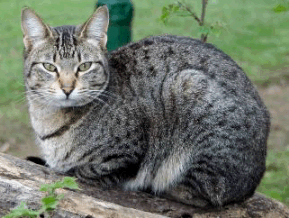
(Photocredit: morguefile.com)
|
Imagine a disease that is infectious yet not contagious, has 100% mortality, virtually no diagnostic test to confirm it, and no effective treatment. When FIP becomes a possibility for a pet cat, questions abound yet not nearly enough are answered plus there is a great deal of older information still circulating. In the past, we have simply linked to other sites to review this complicated infection but after numerous requests to get our own version of a summary, we have decided to cover some basics here in an FAQ format. |
|
WHAT IS FIP?
Feline Infectious Peritonitis is a syndrome that results from wide-spread infiltration of the body’s organs with inflammatory tissues called “pyogranulomas.” The resulting global inflammation leads to the failure of the infiltrated organs, fevers unresponsive to antibiotics, and often the accumulation of thick yellow fluid in the belly or chest. The “wet” form of FIP, includes the effusion of thick, yellow fluid as noted. The “dry” form is more insidious, leading to death over a much longer period (potentially years, but more usually weeks to months). Symptoms still involve fevers and poor appetite with the dry form but also commonly involve deep inflammation in the eyes and nervous system. Both the wet and dry forms have been felt to have 100% mortality, though recently some newer treatments have brought some hope.
|

cat with distended abdomen from fluid accumulation
(original graphic by marvistavet.com)
|
IS FIP CONTAGIOUS?
Very simply, the answer is no. FIP stems from infection with the enteric coronavirus of cats but FIP is not contagious.
|
SO HOW CAN AN INFECTIOUS DISEASE NOT BE CONTAGIOUS?
A contagious disease is spread from animal to animal or person to person. The feline enteric coronavirus is a contagious virus but most cats that get infected just get temporary flu-like symptoms (fever, diarrhea, malaise). Feline Infectious Peritonitis is a very special reaction to infection with the feline enteric coronavirus. Whether a cat gets this devastating reaction to a normally harmless virus is more a function of the individual cat than about the virus. The virus is contagious but a cat cannot transmit FIP to another cat.
|
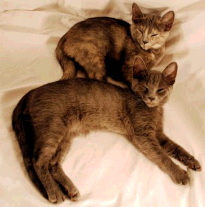
(Photocredit: Morguefile.com)
|
|
WHAT DO WE KNOW ABOUT THE FELINE ENTERIC CORONAVIRUS?
Here are some basics about this virus:
- It is common wherever cats are housed in groups and it is readily transmitted between cats.
- Transmission is typically by contact with infected feces. This means that the litter box is the usual place where infection takes place. Coronavirus infection is unusual in cats that free-roam outdoors (no litter box) or who live in homes where there is only one cat. The virus enters the new host’s body via the nose and mouth. Coronavirus readily sticks to clothing and can be transported easily this way. Coronavirus also survives up to 2 weeks in cat litter dust.
|
|
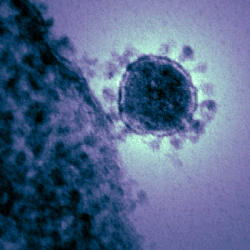
Electron Micrograph of a Coronavirus
showing the characteristic halo-like
structures for which it is named.
(Photocredit: CDC Public Heath Image Library)
|
- An active infection lasts several weeks to a few months. Virus is shed in the infected cat’s stool during this period. If the cat is reinfected, virus sheds again for weeks to months. During this time, the cat may or may not seem at all ill. Some infected cats do not shed virus.
- Households with fewer than 5 cats eventually spontaneously clear of coronavirus. Households with more than 5 cats virtually never clear of coronavirus.
|
 (original graphic by marvistavet.com) (original graphic by marvistavet.com)
|
- Most household disinfectants readily kill coronavirus immediately. Room temperature kills coronavirus within 48 hours. Carpeting is protective to the virus and the virus is able to survive in carpeting for at least 7 weeks.
- Once a cat has been infected with the virus and recovered, the cat can be easily re-infected by continued exposure to infected feces. In this way, many catteries where there are always cats sharing litter boxes never rid themselves of this infection.
- The enteric coronavirus attacks intestinal cells and creates GI upset. As the long as the infection is confined to the GI tract, there will be no FIP.
|
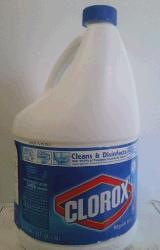
(original graphic by marvistavet.com)
|
TRANSFORMATION OF CORONAVIRUS INTO FIP VIRUS
The process of immunological defeat of the virus involves a cell called a “macrophage.” The macrophage consumes infected material, packages it in special structures which are then flooded with acids and digestive enzymes, destroying the package contents. Any virus inside the package is killed by this process and its components are then used by the immune system to help mount a specific immunological reaction (i.e. make the proper antibodies, send specific killer cells etc.) against further virus.
|
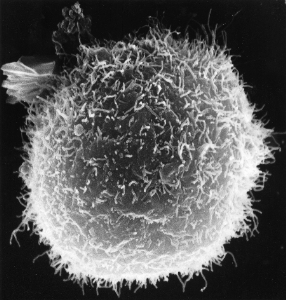
A macrophage is called to areas of inflammation to consume
and destroy cells and organisms that do not belong. The invader's
parts are displayed on the macrophage's outer surface to
facilitate stimulation of antibody producing lymphocytes.
(Photocredit: Public Domain Graphic from United States Department of Health and Human Services)
|
In some cats, a mutation occurs in the coronavirus. This mutation occurs during infection and allows the virus to survive the treatment by the macrophage. Instead of being killed by the macrophage, the virus essentially uses the macrophage to hitch a ride into the body’s core. The macrophage response mounts an attempt to kill the virus but ends up producing heaps of ineffective macrophages and immunologic proteins which make up a special immunologic tissue called a “pyogranuloma." FIP is basically the infiltration of normal organs with pyogranulomas.
The mutation to a form of virus that can cause FIP is more likely to occur in a cat with an immune-compromise. Most cats with FIP are under age 1 year (their immaturity being their immune-compromise). Crowding is also an important source of immune-compromise. Another important factor in mutation is multiple exposure/infections. When cats keep getting reinfected the virus they carry has more chance of mutating to a form that causes FIP.
|
Factors that increase the chance of coronavirus mutation include:
- Genetics
- Early weaning
- Overcrowding
- Age at the time of coronavirus infection
- Surgery stress (usually spay/neuter)
- Sharing litter box with other cats
|
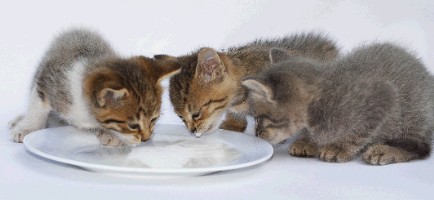
(Photocredit: Morguefile.com) |
WHY ISN’T THE MUTATED VIRUS CONTAGIOUS?
We do not know why. We can inject fluids from a cat with FIP into a normal cat and cause FIP but short of this kind of experimental transmission, the mutated virus doesn’t seem to make it into the natural external secretions of an infected cat. This effectively confines the mutated virus inside the sick cat’s body, though the sick cat will still shed non-mutated virus. It appears that genetics plays a very large role in the mutation of the virus with every FIP cat developing its own unique mutation. A virus that causes FIP in one cat may not do so in another cat.
HOW IS IT POSSIBLE THERE IS NO TEST FOR THIS CLASSICAL DISEASE?
|
We used to think that the difference between getting the “flu” and getting FIP was all about the strain of the virus with which a cat gets infected. Lots of time and effort was spent trying to determine what made the “FIP virus” different from ordinary enteric coronavirus. We no longer think there is a “special” strain of virus that causes FIP. FIP results, as described above, from a mutation that occurs in the virus after infection has occurred. Actually, it's even more complicated: there isn't only one mutation that transforms regular coronavirus into the FIP virus. Many mutations can do it and we may not even have identified all of them. Whether or not these mutation occur in any given infection caes seems to relate more to the immune status of the cat than any factor in the virus. The more virus there is replicating, the greater the chance of one of the FIP mutations occurring. Having an immature or suppressed immune system means more virus replicating.
|

(original graphic by marvistavet.com)
|
|
WHY CAN’T WE JUST TEST FOR MUTATED VIRUS?
The mutation isn’t the same every time. There are two relevant viral genes and the mutation pretty much always involves at least one of them but the mutation can occur in any number of places within either of these two genes. There are currently too many possible mutations to develop a meaningful test.
|
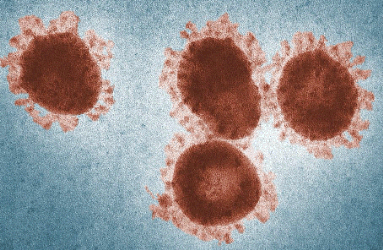 A group of coronaviruses A group of coronaviruses
(Photocredit: CDC Public Heath Image Library) |
WHAT KIND OF TESTING IS AVAILABLE?
At this time the diagnosis of FIP is “clinical.” This means that there is no positive or negative test; the doctor must look at the sum of several findings. These are some of the findings that are coupled with the physical examination and history findings to come up with a diagnosis of FIP.
We have already discussed the symptoms (fevers, eye inflammation, poor appetite, fluid accumulation). Most FIP patients are between ages 3 and 16 months. Most patients get the "wet" form and thus have an effusion of fluid in the belly; in fact, 50% of all belly fluid effusions in cats are caused by FIP. Tests can involve blood or a fluid sample from the chest or belly but it is important to realize that test results are just part of the total picture. There is no definitive blood test for FIP. Here are some tests you may hear or read about:
- Elevations in Total Protein, Alpha-2 and/or Gamma Globulins
Total serum protein is a simple value that can be checked in virtually every animal hospital in a matter of minutes. Cats with FIP commonly have very high serum protein levels. That said, there are many types of proteins in the blood. If a blood panel is checked on a cat with FIP, serum protein is often divided into albumin and globulin amounts (adding these together provides the “total protein” level.) When protein levels are broken down into these two groups, it will be the globulin level that is elevated. If the globulin level is further broken down, using a special test called “electrophoresis,” it will be found that it is the “gamma globulin” and "alpha-2 globulin" levels that are elevated. The gamma globulins include antibodies and the FIP infection classically creates so much immune reaction that all antibody levels are elevated.
|
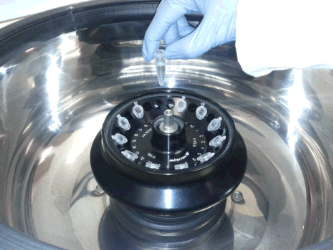
(Photocredit: Morguefile.com)
|
- The Albumin to Globulin Ratio
FIP tends not only to elevate globulin levels but it also tends to decrease albumin levels. Albumin is an important carrier protein in the blood and one’s body tends to conserve it at all costs. Albumin can be lost through glomerular disease, protein-losing enteropathy, or it can be under produced by a failing liver. All these conditions can occur with FIP. If the albumin to globulin level is less than 0.8, there is a 92% statistical chance that the cat has FIP. If the ratio is greater than 0.8 there is a 61% chance the cat does not have FIP.
- The FIP Titer
This test is often included on a feline blood panel and reflects a cat’s circulating antibody level against coronavirus. The problem is that exposure to coronavirus is common in cats and is not particularly meaningful in diagnosing FIP. Further, cats with fulminant FIP may not be producing FIP antibodies and can have negative titers. The only time such a titer might be useful is if one is screening a healthy cat for coronavirus; in this event a negative titer would indicate that the cat will not be shedding virus and can be introduced into a coronavirus free living situation. Many breeders strive for coronavirus-free catteries and such screening is important. The test is not helpful in diagnosing FIP in a sick cat, however.
- Testing the Belly/Chest Fluids
FIP classically produces a clear but viscous yellow effusion, usually in the belly but possibly in the chest or in both locations. The fluid typically has a total protein level greater than 3.5 mg/dl. Several efforts to find a diagnostic test that could be performed on this fluid have been made. So far we know that “typically” FIP fluid is high in lactate dehydrogenase, alpha-amylase, and alpha-1 glycoprotein. The presence of such proteins provides evidence of the inflammatory nature of the fluid and would be evidence pointing towards FIP (though any other inflammatory fluid would yield similar results).
- “Rivalta’s Test”
This is a test with which few veterinarians are familiar but it can be very helpful in the diagnosis of FIP. A test tube is filled with distilled water and one drop of 98% acetic acid is added. To this mixture one drop of effusion is added. If the drop dissipates, the test is negative. If the drop retains its shape, the test is positive. A negative Rivalta’s test is 97% accurate in ruling out FIP. A positive test is 90% accurate in ruling in FIP in cats under age 2 years of age.
- PCR Testing
PCR testing is an extremely sensitive method for detecting DNA, in this case coronavirus DNA. The advantage it has over traditional antibody titers is that it distinguishes active virus infection from past exposure. At least at this time, PCR testing cannot distinguish mutated FIP-causing virus from regular coronavirus.
|
 High protein droplet indicating High protein droplet indicating
a positive Rivalta's test.
(Photocredit: Kalumet via Wikimedia Commons) |
- Immunofluorescent Coronavirus Staining of the Effusion
In this test the effusive fluid is tested immunologically for presence of coronavirus using antibodies tagged with fluorescent dyes. In a study using a large number of cats, there were no false positives meaning that if this test is positive there is a 100% confirmation that the cat has FIP. Unfortunately, if the test is negative that does not mean the cat does not have FIP (only 57% of negatives did not have FIP).
- Tissue Biopsy
Most FIP cats are too sick for surgery, though sometimes flushing away the belly effusion surgically provides a “rally” of improvement temporarily. A tissue sample is the best method for confirming FIP as there are few conditions that create pyogranulomas throughout the body but if regular biopsy is equivocal, tissues can be stained for the presence of coronavirus and only in FIP will there be enough coronavirus within macrophages for positive staining. A positive tissue stain is 100% accurate in confirming FIP.
IS THERE REALLY NO EFFECTIVE TREATMENT?
|
There are two very promising medications: GC376 (also called "CL-Pro") and GS-441524 (marketed as "remdesivir). It appears that GC376, a protease inhibitor, is on its way to commercial availability. In experimental trials, the medication was given by injection twice daily. Young kittens (with newer infections) can experience cure after 12 weeks of treatment but cats with the dry form or with more long-standing infections may need indefinite treatment. This medication is not able to penetrate the natural blood/brain barrier and thus is not helpful if a neurologic form of FIP develops. Some cats experience sores at the injection sites and while these were felt to be minor, some scarring was permanent. The drug also prevented development of adult teeth leaving cats with their baby teeth still in place. Extractions of these teeth were frequently necessary. Out of 20 naturally infected cats and kittens, six were permanently cured and were able to discontinue medication.
|
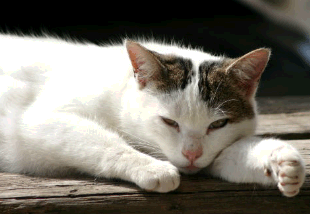
(Photocredit: Morguefile.com)
|
Results with GS-441524, a nucleoside analog, were better. Fewer side effects and relapses were readily dealt with by using higher doses. A few of the cats in the clinical trial died of unrelated conditions but the remaining 26 cats were able to achieve cure. GS-441524 is able to cross the blood/brain barrier with higher doses and treat the neurologic version of the disease. The bad news (for cats) is that this medication, produced by Gilead Sciences, is being developed for treatment of Covid-19 (in addition to the human Ebola virus) and the feline market is of low priority.
Black market sources have emerged for both medications, especially based in China. There is virtually no quality control for these substances and the conversion from powder to injectable, which is no small chemical feat, is done with unknown processes on the black market. Toxicity, contamination and other issues are problematic and, while cat owners may be desperate, the use of black market chemicals is discouraged. As of June 1st, 2024, Stokes pharmacy at stokespharmacy.com expects to have a legal compounded product.
Without one of the products mentioned above, there is no effective treatment for FIP and you should discuss options with your veterinarian.
ARE THERE ANY OTHER OPTIONS?
Here are some treatments that are being explored or which have been explored:
- Improved circulation
A medication called pentoxyphylline improves red blood cell flexibility to allow better circulation through organs damaged by the pyogranulomas. This is not felt to be a particularly effective treatment but it is not likely to hurt and might confer some better tissue oxygenation.
- Removing the effusion
Suctioning of the effusion will ease the difficulty breathing of a cat with fluid in its chest but even removing the effusion from the belly helps remove a large source of inflammation. Some cats experience a temporary improvement with the fluid removed.
- Antiviral Drugs
Ribavarin was tested and not found to be helpful. Some types of interferon have been studied but no benefit has been definitive.
- Polyprenyl Immunostimulant
This immunostimulant works by improving the numbers of helper T lymphocytes and improving the patient's own immune response against the coronavirus. This medication is labeled for Feline Herpes virus infection but has also shown success in treatment of the dry form of FIP (but not the wet form). Investigation is on-going.
WHEN A CAT DIES OF FIP WHAT IS THE INFECTION RISK TO THE REMAINING CAT?
|
You can bet that the roommate has already been infected with the coronavirus. If there are only one or two surviving cats, the chances are that in time the virus will completely clear and they will stop getting reinfected. Surviving cats are felt not to have any higher risk over the general population for developing FIP from their coronavirus, though a littermate of the FIP cat might have a slightly higher incidence due to predisposing genetic factors.
|

|
WHEN IS IT SAFE TO GET ANOTHER CAT AFTER ONE DIES OF FIP?
Since this is not a contagious disease, one does not need to wait before getting another cat. If one wants to see that there is no remaining coronavirus around the house leftover from the deceased cat, a 3 month period has been advocated; however, since coronavirus is very common (in one study 90% of shelter kittens were infected and shedding virus), it is not easy to insure that the new cat will not be carrying virus already. The short answer is, as long as there are fewer than 5 cats in the home, FIP is not likely to continue to be of concern.
ISN’T THERE A VACCINATION?
|
Developing a vaccination has historically been fraught with difficulty simply because it is the immune response against the virus that causes the disease. How does one make a vaccine without creating the same immune response against the virus? Zoetis (formerly Pfizer Animal Health) has developed the only FIP vaccine on the market by using a temperature sensitive mutant coronavirus. This virus is inoculated into the cat’s nose. The virus is incapable of spreading beyond the nose and throat because it cannot survive at body temperature. In the nose and throat, however, it generates a localized immune response that prevents a coronavirus from effectively entering the body. The effectiveness of this vaccine has been questionable and remains in controversy. The vaccine is given to cats over age 4 months of age and is thus not helpful in the chief situation where a vaccine could do the most good: the breeding cattery. Because most cats are not at risk for FIP infection and those that are, are at risk at an age too young for the vaccine, most veterinary teaching hospitals do not stock this vaccine.
|
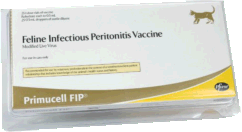
|
The ideal candidate for vaccination would be an uninfected cat going to a cattery where litter box sharing is likely. This would seem to be an unusual situation but it might come up in these circumstances:
- A feral cat is moved into an indoor or shelter colony. (It is not unusual for FIV+ cats, that is, cats infected with the Feline Immunodeficiency Virus, from feral colonies to be removed from the colony and put in a sanctuary for FIV+ cats).
- A cat from a single cat home is released to a rescue group goes to a foster home where there are a large number of other cats already present.
- A cat moves from a single cat home to live in a multi-cat home.
Vaccination was able to reduce the infection rate in exposed cats but not all cats will be protected.
IS INFECTION LIMITED TO CATS?
Yes. Dogs and humans cannot get sick from feline coronavirus. The feline enteric coronavirus is not involved in SARS (severe acute respiratory syndrome) nor Covid-19 though both forms of SARS are caused by coronaviruses.
The information in this summary was largely drawn from the following article:
K. Hartmann. Feline Infectious Peritonitis. Veterinary Clinics of North America Jan 2005; 39-79.
We still include the following external links for further information:
For General Information:
(A Good Starting Point)
www.newmanveterinary.com/fip.html
For a Really Good FAQ:
(Frequently Asked Questions)
www2.vet.cornell.edu/departments-centers-and-institutes/cornell-feline-health-center/health-information/feline-health-topics/feline-infectious-peritonitis
About On-Going Research
www.sockfip.com
FIP is a serious disease with near 100% mortality, no good test, no good treatment, and no good vaccine. If your cat is an FIP suspect, we know how painful the lack of knowing can be. We hope the links above can provide facts and understanding during this difficult time.

Page last updated: 7/1/2024
|